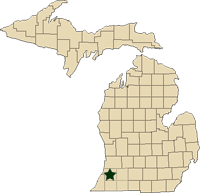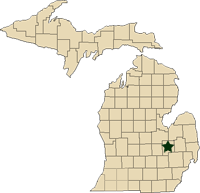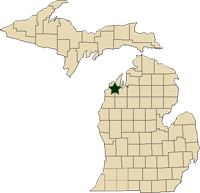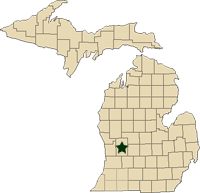Michigan apple maturity reports – September 21, 2011
Each week, MSU Extension educators test apples for maturity in their region and report the status.
This week’s regional reports:
- Southwest Michigan - Bill Shane, Mark Longstroth, Diane Brown
- Southeast Michigan - Bob Tritten and Debbie Clark
- Northwest Michigan - Nikki Rothwell and Karen Powers
- Grand Rapids Area – Phil Schwallier, Amy Irish-Brown, Denise Ruwersma
Southwest Michigan – Bill Shane, Mark Longstroth, Diane Brown Michigan State University Extension
|
This is the third weekly apple maturity report for southwest Michigan. The samples for these reports are collected primarily in Berrien and Van Buren counties. The maturity is only a broad indication of trends for this area. Individual orchards may differ from these results.
General comments
Harvest of Gala for long-term storage is done and harvests of Honeycrisp, Empire and Jonathan are brisk. Stop drop sprays have been important as apples are showing tendencies to drop this year. Oriental fruit moth catches are still significant in some area orchards, compelling growers to spray to protect late season varieties. Pheromone traps and their pheromone-releasing capsules should be kept in good shape in order to provide accurate information about these late season sprays.
Table 1. Summary of Berrien County area apple maturity samples taken September 9 and 12, 2011.
|
Variety |
Firmness lbs pressure (range) |
Starch (range) |
Brix (range) |
|
Empire |
16.6 (18.1 – 15.5) |
4.3 (6.6 – 2.4) |
12.0 (13.2 – 10.8) |
|
Jonagold |
17.4 (18.8 – 15.1) |
5.9 (4.6 – 7.8) |
13.0 (14.9 – 11.9) |
|
Jonathan |
17.8 (19.1 – 17.1) |
4.2 (5.4 – 2.0) |
12.3 (13.5 – 10.0) |
|
Golden Delicious |
17.6 (18.7 – 16.5) |
2.7 (4.2 – 1.6) |
13.0 (14.1 – 11.7) |
|
Red Delicious |
17.7 (19.4 – 16.9) |
2.5 (3.0 – 1.6) |
10.5 (11.7 – 9.2) |
|
Early Fuji |
16.7 (17.8 – 16.1) |
6.3 (7.2 – 5.4) |
15.9 (16.6 – 14.7) |
Gala and Honeycrisp
No more samples this week.
Empire (six sample sites)
Firmness this week averages 16.6 lbs., range 18.1 to 15.5 lb., from export to long-term controlled atmosphere firmness. The starch removal index average is 4.6 compared to 2.7 for last week, now ranging from immature to over-mature. The brix is averaging 12 compared to 11.2 degrees for last week. Harvest for taffy apples and fresh apple slices has been underway for several weeks and harvest for fresh market has begun. According to this week’s sampling, harvest for domestic fresh market sales can be delayed in most orchards. Stop drop sprays have been important for this variety this year. The estimated peak harvest date for Empire destined for long term CA storage for the Benton Harbor region is September 21.
Jonagold (11 sample sites)
This is the second week of sampling. Firmness is averaging 17.4 lbs., most in the excellent firmness range, but getting close to the 16 lb. threshold for mid-term CA storage. Starch conversion has changed markedly since last week, now averaging 5.9, ranging from mature to over-mature range. Brix is averaging 13.0 degrees. Growers need to carefully assess maturity in their Jonagold blocks as some have gone beyond the ideal point for long-term CA storage.
Jonathan (seven sample sites)
Firmness averaging 17.8 lbs., last week was 18.1 lbs. All sites sampled this week had firmness in the excellent range, with starch conversion averaging 4.2 compared to last week’s 3.1, now ranging from immature to mature. Brix averages 12.3 compared to 11.8 for last week. Harvest for the fresh market can be delayed in most orchards to wait for better size, skin color and flesh maturity. The estimated peak harvest date for Jonathan destined for long term CA storage for the Benton Harbor region is September 26. Harvest of Jonathan has been brisk this past week.
Golden Delicious (nine sites)
This is the second week of sampling. Firmness is averaging 17.6 lbs. (excellent firmness), compared to last week’s 18.5 lbs. and current starch removal index of 2.7 ranging from immature to mature compared to last week’s 1.6, with brix average of 13.0, compared to last week’s 11.9. Harvest of Golden Delicious for the fresh market can be delayed in most sites based on these tests. However, a few sites are approaching long-term CA condition. The estimated peak harvest date for Golden Delicious destined for long term CA storage for the Benton Harbor region is October 1, but it appears that maturity is proceeding ahead of the predicted date.
Red Delicious (six sites)
Fruit firmness in this first week of sampling is averaging 17.7 lbs. (range 19.4 to 16.9 lbs.) in the excellent to mid-term controlled atmosphere recommended guidelines. Starch conversion is averaging 2.5 (range 1.6 to 3), immature to mature. Brix is averaging 10.5 degrees with a range of 9.2 to 11.7. Firmness is low enough to be of concern in a few blocks. Like Golden Delicious, this variety is ahead of the predicted peak harvest date of October 1 for the Benton Harbor region
Early Fuji (five sites)
These are the strains such as September Wonder, Morning Mist, Auvil Early Fuji and Nickell Fuji that ripen approximately a month ahead of traditional Fuji. Firmness averaged 16.7 lbs. (range 17.8 to 16.1) in the long term to mid-term CA firmness. Starch removal is quite advanced, averaging 6.3 (range 5.4 to 7.2) with brix average of 15.9 and range of 14.7 to 16.6. These varieties generally have 40 to 98 percent red blush. Early Fuji types are generally ready for harvesting.
Contact MSU fruit educator Bill Shane at the Southwest Michigan Research and Extension Center at 269-944-1477 ext. 205 if you would like to have samples from your farm tested for maturity. See the MSU Extension News for Agriculture website for more information, including reports from other regions, and the MSU apple website for information about apple maturity and apples in general.
This report and project is made possible by the support of our sponsors, which include Valent Biosciences, Michigan Apple Committee, Michigan State Horticultural Society, MSU’s AgBioResearch and Michigan State University Extension. Southwest Michigan growers providing apples include Grandview Orchards, Mammoth Farms, Oak Hill, Bixby Orchards, Weber Farms, Meachum Farms, Kevin Winkel Farms, Weckwerth Farms, Willmeng Farms, and Czuba Farms.
Apple maturity trends for southwest Michigan. Each dot is the average for an orchard based on a 10 apple sample.
Samples were taken in Berrien and Van Buren counties.
Click here to view larger image.
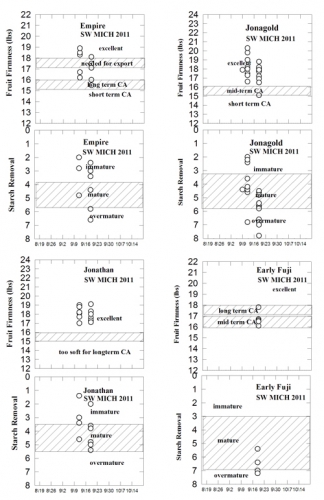
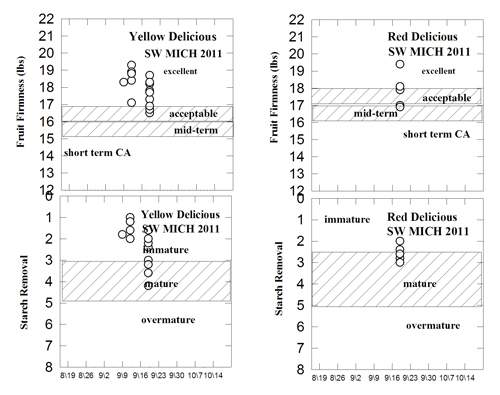
Southeast Michigan – Bob Tritten and Debbie Clark, Michigan State University Extension
|
General comments
Apple harvest continues in full swing across the region. Most growers are finishing up on McIntosh, completing the last picking of Honeycrisp, and are going back to harvest ReTain-treated Gala blocks. Labor supplies are good across the region and, with the exception of rain on Monday, harvest operations have not been interrupted by bad weather. For direct marketing (farm marketing and pick-your-own) operations, demand has been excellent thus far this season. Many folks reported having one of their busiest September weekends ever this past weekend.
This week I sampled nine varieties of apples, starting with a few McIntosh and Honeycrisp samples and, for the first time, Red Delicious and Fuji as I look down the road at their maturity. Macs and Honeycrisp are over mature at this time; Jonathon and Jonagold are just approaching or are in the mature window. Empire and Golden Delicious are a few days off and Cortlands appear to be a least a week away from being ready for harvest. I was surprised to see that both Red Delicious and Fuji were further along than what I had anticipated.
My feeling is that apples are ready for harvest a few days earlier than the predicted harvest dates published this summer. With the wild weather season that we have had this year, these dates are rather fluid and varieties do not appear to be maturing in the order they normally do.
Table 1. Apple Maturity in east Michigan for apples harvested on September 19, 2011.
|
Variety |
% Fruits with Ethylene over 0.2 ppm (Range) |
Color (Range) |
Firmness lbs (Range) |
Starch (Range) |
Brix % |
|
McIntosh |
100% (100-100%) |
84% (83-85%) |
15.0 lbs (14.2-15.7) |
6.7 (6.5-6.9) |
11.6% |
|
Honeycrisp |
100% (100-100%) |
84% (75-90%) |
15.3 lbs (13.5-17.6) |
7.0 (6.0-8.0) |
12.2% |
|
Jonathon |
55% (10-100%) |
77% (70-83%) |
15.4 lbs (15.2-15.6) |
4.0 (3.8-4.2) |
12.0% |
|
Jonagold |
18% (10-30%) |
57% (40-87% |
16.9 lbs (16.3-17.6) |
4.2 (3.1-5.6) |
12.1% |
|
Empire |
20% (0-60%) |
77% (71-87%) |
16.3 lbs (14.9-17.8) |
3.0 (2.0-3.7) |
10.9% |
|
Cortland |
65% (50-90%) |
79% (73-84%) |
16.0 lbs (15.4-17.0) |
1.9 (1.5-2.3) |
11.4% |
|
Golden Delicious |
58% (20-90%) |
21% (17-23%) |
16.8 lbs (16.5-17.1) |
3.2 (1.5-3.8) |
12.8% |
|
Red Delicious |
53% (30-70%) |
93% (90-95%) |
17.2 lbs (16.4-18.2) |
2.2 (2.1-2.3) |
11.3% |
|
Fuji |
10% (10-10%) |
72% (61-82%) |
16.8 lbs (16.1-17.4) |
2.2 (1.8-2.5) |
11.3% |
Individual variety results
McIntosh were sampled for the third week of the season and a much smaller sample was taken this week than last week as most McIntosh have now been harvested. Growers have stopped and started harvesting McIntosh a number of times over the last couple of weeks, as color was so poor. Color, indeed, has improved greatly over the last week with the warm days and cold morning temperatures that we have had. McIntosh are over-mature at this time and should be used for immediate sales fresh or some even for processing into cider or other uses. One-hundred percent of the McIntosh showed internal ethylene levels greater than 0.2 parts per million (ppm). Their color has jumped from 68 percent last week to 84 percent this week and background color has also improved greatly. The fruit is still fairly firm at 15.0 lbs., however, the starch index has jumped dramatically from 5.3 last week to 6.7 this week with a brix of 11.6 percent. With the starch index of 6.7, this is an indication that these are over-mature and need to be harvested and marketed quickly.
Honeycrisp were sampled for the third week of the season and a very limited number of samples were taken because most Honeycrisp have now been harvested. One-hundred percent of the fruit showed internal ethylene greater than 0.2 ppm, this is relatively unchanged from last week’s number. The color on Honeycrisp has increased dramatically from 65 percent last week to 84 percent this week. Background color has also improved and fruit remain fairly firm at 15.3 lbs. The starch index has also jumped dramatically from 5.7 last week to 7.0 this week, with a brix of 12.2 percent. Honeycrisp are physiologically mature and ready for their final picking. Most growers are currently at the end of picking. Honeycrisp fruit looks rough at many farms this year with a poor quality fruit finish. A great deal of cracking is present, caused from sunburn. Lastly, some splitting or cracking of the cuticle or skin occurred as fruit was very close to harvest. In last week’s report, I encouraged growers to pick Honeycrisp earlier than later and to move forward with a final picking regardless of color. I would make the same comment today.
Jonathon were sampled for the second week of the season, with 55 percent of the fruit showing internal ethylene levels greater than 0.2 ppm. This number is up from 40 percent last week. The color has improved from 66 percent last week to 77 percent this week. Background color has also improved and the fruit firmness has dropped from 17.8 lbs. last week to 15.4 lbs. this week. The starch index has jumped from 2.9 last week to 4.0 this week, with a brix of 12.0 percent. Some blocks of Jonathon are ready for harvest for long-term storage and are very close to being ready to harvest for short-term sales. Many cider makers are also looking forward to having ripe Jonathon to add to their cider blend.
Jonagold were sampled for the second week of the season. While most growers have not started harvesting Jonagold, based on these numbers I would say that Jonagold are ready for harvest for fruit that is destined for long-term or controlled atmosphere storage. Jonagold are not developing very much internal ethylene as of yet; this is untypical of this variety. Color is not the greatest, averaging at 57 percent. Background color has improved to 2.8 and the fruit firmness is still good at 16.9 lbs., dropping from 17.7 lbs. last week. Starch index has jumped up one full point from 3.2 last week to 4.2 this week and the brix is 12.1 percent. For fresh or immediate sales, I feel that Jonagold are not quite ready yet, but are very close. Keep a close eye on them late this week and over the weekend as some may be available for harvest.
Empire were sampled for the second week of the season with 20 percent of the fruit showing internal ethylene levels greater than 0.2 ppm. Empire color has improved a bit to 77 percent and the background color has also improved a bit, dropping to 2.5. The fruit remains firm at 16.3 lbs. and the starch index has moved from 2.4 last week to 3.0 this week, with a brix of 10.9 percent. Empire are still eating very green and are not physiologically ready for harvest yet. I would estimate that we are about a week away from the beginning of harvest of Empire destined for long-term and controlled atmosphere storage, and just a few days longer for fresh market sales.
Cortland were sampled for the second week of the season. The internal ethylene levels of Cortland have risen to 65 percent of the fruit, showing internal ethylene levels greater than 0.2 ppm. The color has improved market ably to 79 percent this week and the background color has dropped to 3.3. Cortland fruit firmness is 16.0 lbs., with a starch index of 1.9 and a brix of 11.4 percent. Cortland are not ready for harvest and need at least another week before they might be considered. I need another week’s data to tell whether or not Cortlands will be ready a week from now – it may be longer.
Golden Delicious were sampled for the second time this harvest season. The strain that I have been trying to center on for most of my sampling has been Smoothee. Fifty-eight percent of the fruit are showing internal ethylene levels greater than 0.2 ppm – last week that figure was 13 percent. The color is starting to improve, however the background color is still poor for Golden Delicious. The fruit remain firm at 16.8 lbs., dropping from 17.2 lbs. last week. The starch index has risen from 2.1 last week to 3.2 this week and a brix of 12.8 percent. Golden Delicious are further along than Cortland and physiologically are at the same point of maturity as Empire. I would expect that in another week some earlier maturing strains of Golden Delicious will be ready for harvest.
Red Delicious were sampled for the first time of the season. I was surprised to see that 53 percent of the fruit showing internal ethylene levels greater than 0.2 ppm. Color is excellent on Red Delicious this year, now at 93 percent. They are still at fairly poor background color at 2.0 and are still very firm at 17.2 lbs. The starch index is 2.2, which I was surprised to see it quite so high this early. The brix is 11.3 percent. I need another week’s worth of data to give me a better read on Red Delicious maturity, but I think that we are about 10 days to two weeks away from it being ready.
Fuji were sampled for the first time of the season. Very little of the fruit (10 percent) are showing internal ethylene levels greater than 0.2 ppm. Color is fairly good at 72 percent and background color is still green at 3.5. The fruit are firm at 16.8 lbs. and had the same starch index as Red Delicious of 2.2. The brix is 11.3 percent. Fuji are, most likely, a couple of weeks away from being ready for harvest, but here again I would like to see another week’s worth of data to zero-in on a date more closely.
Table 2. Predicted harvest dates
|
Full bloom date |
Original Predicted Harvest Dates |
Revised Predicted Harvest Dates |
|||||||
|
Station |
McIntosh |
Jons |
Reds |
McIntosh |
Jons |
Reds |
McIntosh |
Jons |
Reds |
|
Deerfield |
5/13 |
5/15 |
5/17 |
9/15 |
9/29 |
10/5 |
9/20 |
10/4 |
10/10 |
|
Romeo |
5/19 |
5/21 |
5/21 |
9/17 |
10/2 |
10/8 |
9/22 |
10/7 |
10/13 |
If you have any questions regarding this apple maturity report or apple harvest in southeast Michigan, email me or don’t hesitate to email me or call my office (810-244-8555) or my cell (810-516-3800).
This report and project is made possible by the support of our sponsors, which include Valent Biosciences, Michigan Apple Committee, Michigan State Horticultural Society, MSU’s AgBioResearch and Michigan State University Extension. Southeast Michigan apple growers that are providing apples on a weekly basis include Spicer Orchards in Hartland, Erwin Orchards in South Lyon, Westview Orchards in Romeo and Hy’s Cider Mill in Romeo. Many thanks to the support of these growers.
Northwest Michigan – Nikki Rothwell and Karen Powers, Michigan State University Extension
|
General comments
The Northwest Michigan Horticultural Research Station (NWMHRS) will be testing apples for maturity for 2011. If growers are interested in having fruit tested, they should drop off a 10 to 12 apple sample at the NWMHRS on Mondays. Fruit should be picked randomly from the outside portion of the trees and should be large in size and free of blemishes with the stem attached.
We tested five varieties this week and the fruit has moved along compared to last week’s samples. However, there is a bit of a lull at this time as Gingergolds have been harvested, and growers are waiting on maturity in many varieties. There is some spot-picking of Honeycrisp, and Graham Spy are also being picked at this time. Most growers are ready to start picking and boxes are in place in the orchards. Color has improved on most varieties and the cool nights and sunny days over the weekend helped with color. Quality of apples remains high across the region, despite a small amount of hail last week.
Summary of northwest Michigan apple maturity samples taken on September 19, 2011
|
Variety |
Color % (range) |
Firmness lbs. pressure (range) |
Starch (range) |
Brix (range) |
|
Gala (4) |
91 (85-99) |
19.3 (18.2-20.8) |
1.5 (1.2-1.9) |
10.7 (9.8-11.3) |
|
McIntosh (5) |
90 (80.5-98) |
15.2 (14.5-17.2) |
2.6 (1-3.2) |
10.9 (10.2-12.4) |
|
Honeycrisp (4) |
77 (66.5-84.5) |
16.3 (14.8-19.9) |
4.5 (1.8-6.9) |
12 (10.6-15) |
|
Golden Delicious (3) |
32 (21-45) |
18.6 (18.2-18.8) |
1.6 (1.1-2) |
11.7 (11-12.8) |
|
Jonagold (3) |
83 (69-97) |
19 (17.6-19.5) |
1.8 (1.3-2.3) |
11.9 (11.2-12.6) |
NWMHRS predicted harvest dates
|
Full Bloom |
Predicted Harvest |
||||
|
McIntosh |
Jonathan |
Red Delicious |
McIntosh |
Jonathan |
Red Delicious |
|
23-May |
27-May |
27-May |
24-Sep |
10-Oct |
16-Oct |
|
Dates Compared to Normal |
Dates Compared to 2010 |
||||
|
McIntosh |
Jonathan |
Red Delicious |
McIntosh |
Jonathan |
Red Delicious |
|
-2 |
-4 |
1 |
-20 |
-23 |
-23 |
Gala. Immature (four samples). Firmness of Galas still has not changed in the past week and most samples still have firmness’s in the 19-pound pressure range. Starch index levels also remain constant and are only in the 1 to 2 range. This variety seems to be slower to ripen than other varieties. Color has improved over the last week to an average of 91 percent.
McIntosh. Approaching mature (five samples). Fruit firmness has dropped over the last week, but is still in the 14- to 17-pound range. Starch index is still fairly low, with an average of 2.6, and apples still eat on the green side. Color has improved to 90 percent.
Honeycrisp. Immature (four samples). Firmness in Honeycrisp has not changed much over the last week in most blocks, but there is quite a bit of variability in the starch removal index. Some blocks are reading in the 6 to 7 range while other blocks only have a starch removal of 1 to 2. There is variability in ripening across blocks. Color has improved quite a bit over the last week from 69 to 77 percent. This variety needs multiple pickings over several weeks for premium quality fruit.
Golden Delicious. Immature (three samples). Golden Delicious are still very firm at this time and the average pounds of pressure is 18.6. Starch removal is an average of 1.6 and there is just starting to be a pink blush on the apple cheek.
Jonagold. Immature (three samples). Jonagolds are firm and the color is looking good with an average of 83 percent. The brix was a bit of a surprise, where the samples averaged a brix reading of 11.9.
Grand Rapids Area – Phil Schwallier, Amy Irish-Brown, Denise Ruwersma, Michigan State University Extension
|
General comments
In the Grand Rapids area, the weather has been cooperative with some cooler temperatures and sunny days that have really helped to color fruit. Rain on September 19 was appreciated with totals ranging from 1/10 to 1 inch depending on site. Most growers are reporting picking out just about what they expected with occasional blocks picking slightly heavier than anticipated. For those sites that had serious apple damage form hail this summer, harvest is underway to get those fruits off for the juice market before rots set in.
The Hart and Shelby area can expect harvest dates to be behind the Grand Rapids area using this guide: along the lakeshore, approximately six days behind Grand Rapids; areas inland, about four days behind; and add another two days behind for those blocks with a very heavy crop.
Summary of Grand Rapids apple maturity samples tested September 20, 2011.
|
Variety |
Predicted Harvest Date |
Avg. Ethylene (ppm) |
% Fruits with Ethylene over 0.2 ppm |
% Red Color (range) |
Firmness lbs pressure (range) |
Starch (range) |
Brix (range) |
|
Gala |
12-Sep |
1.65 |
100% |
55% (10-80%) |
14.9 (12.5-18) |
6.7 (6-8) |
10.56 (10-11.2) |
|
Ruby Mac |
16-Sep |
0.095 |
20% |
100% |
15.8 (14.3-17.5) |
5.9 (4-7) |
12.7 (12-13) |
|
Linda Mac |
16-Sep |
0.147 |
40% |
95% (85-100) |
17.4 (15-19.5) |
5.4 (4-6) |
12.9 (12-13.5) |
|
Blushing Golden |
19-Sep |
0.037 |
0% |
30% (10-50) |
17.1 (15-19.3) |
5.6 (4-8) |
9.8 (9.5-10) |
|
Honeycrisp |
20-Sep |
5.2 |
90% |
53% (30-80) |
16.8 (15.5-18.5) |
5.4 (2-7) |
11.9 (11.5-12.5) |
|
Empire |
24-Sep |
0.052 |
0% |
66% (35-90) |
16.6 (14-18.3) |
2.75 (2-3) |
10.1 (10.2-10.6) |
|
Early Fuji |
28-Sep |
0.442 |
60% |
87% (60-95) |
14.1 (12.5-16.3) |
4.2 (2-6) |
12.8 (12.2-13.5) |
|
Jonathan |
29-Sep |
0.177 |
30% |
100% |
15 (11.5-16) |
4 (4-6) |
11.6 (11.2-11.9) |
|
Jonagold |
30-Sep |
0.093 |
10% |
54% (45-75) |
16.3 (14.5-19.6) |
5.5 (4-7) |
11.3 (10.8-11.5) |
|
Cortland |
10-Oct |
0.129 |
30% |
95% |
17.7 (15-20) |
1.6 (1-2) |
12.4 (12-13) |
|
NovaSpy |
10-Oct |
0.115 |
10% |
84.5% (75-90) |
18.6 (16.5-19.5) |
3.2 (2-5) |
12.9 (12-13.5) |
Gala
Gala are moving very quickly through the maturity stages. Most non-Retain treated strains are now in the short-term CA storage window. Brix readings are a little on the low side for samples this week. Retain treated Galas have started to color up nicely and harvest continues for those fruits which are still in the long-term storage window.
McIntosh
Quite a few Macs have been harvested in the last five days. The fruits sampled this week indicate that we are right in the optimum range for long term CA storage of Macs. Ethylene continues to be lower than expected with only 20 to 40 percent of fruits tested being over 0.2 ppm this week. Pressure readings are still good at 12.7 to 12.9 pounds. Color is good to excellent (note that sampled fruits are the more red colored strains). Brix levels are about the same as last week, yet fruit eat much better this week. Starch clearing is increasing from 4’s last week to nearly 6 this week. There is still not too much drop being reported in Mac blocks, but be wary of storms and get them off if there is a threat for winds or apply stop drop NAA ahead of windy conditions.
Honeycrisp
The Grand Rapids area is right in the middle of Honeycrisp harvest now. Starch readings continue to be in the 5 range this week. Brix levels have improved from 11 last week to 11.9 this week. In the last few days, fruit eating quality has improved greatly. This will be a big week for Honeycrisp on the Ridge.
Empire
Are still immature overall from our samples, which are not treated with Retain. Since most Empires have been treated with Retain this year, expect your harvest window to be even later than the data reflects in this report.
Early Fuji
September Wonder was the early Fuji strain tested this week. They are now in the optimal window for fresh fruit sales. Keep in mind that these early strains of Fuji can be 30 days ahead of regular Fuji. We don’t know everything about optimum harvest dates for some of these early Fuji strains, so watch them closely if you have them on your farm.
Jonathan
Overall, Jonathan is immature, but they seem to be moving slowly towards the long-term CA storage window. There is some harvest of the redder strains occurring for the fresh market and taffy apple market. The major harvest window for Jonathan for long-term storage will open up next week. They really need another week to pick up some size too.
Jonagold
The predicted harvest date in the Grand Rapids area for Jonagold is September 30. From samples this week, we know that they are still immature, but slowly moving forward. It looks like the September 30 date will be a good target. Internal ethylene readings have moved up a little, but still indicate immaturity. Firmness is still very high at 16.3 pounds on average. Starch clearing is up from 3.9 last week to a surprising 5.5 this week. Brix readings have improved from 10.7 last week to 11.3 this week. Many Jonagold blocks are treated with Retain this year, and those blocks will be delayed in development compared to the untreated fruits in our samples.
Cortland
Cortland are still very immature.
NovaSpy
This newer strain of Spy looks very good. They are still immature.
Golden Delicious
Golden Delicious were not sampled this week. The predicted harvest date is October 2 for Goldens. We will start sampling them next week. In southwest Michigan, they report that Goldens are still immature, but are nearing the long-term CA storage window. Southeast Michigan reports about the same.



 Print
Print Email
Email